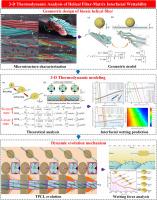3-D thermodynamic analysis of helical fiber-matrix interfacial wettability
IF 9.4
1区 工程技术
Q1 ENGINEERING, MECHANICAL
International Journal of Mechanical Sciences
Pub Date : 2025-09-27
DOI:10.1016/j.ijmecsci.2025.110896
引用次数: 0
Abstract
In recent years, the advancement of material design has highlighted the importance of integrating bionic principles into the design process. Helical bionic fibers have garnered considerable attention in advanced materials. Unlike conventional fibers, 3-D helical fibers exhibit curvature-driven spatial topologies that enhance surface tension interactions with polymer matrices, thereby resulting in distinct fiber-matrix interfacial wetting. However, the absence of quantitative thermodynamic models has limited the ability to predict such interfacial phenomena. In this study, a novel 3-D thermodynamic model based on Gibbs free energy is proposed for the first time to assess the fiber-matrix wettability in pre-cured composites. This model explicitly captures the free-energy landscape associated with spatial topology, and uniquely elucidates previously unexplored mechanisms of wetting transitions between Cassie-Baxter and Wenzel states. By adjusting the spatial topology of individual fibers, the effects of the morphological evolution on the helical fiber-matrix interfacial wettability were systematically investigated, enabling the prediction of optimal helical configurations. The number of individual fibers has a dual effect on interfacial wetting, revealing the interplay between the helical fiber design and matrix wetting behaviour. These findings reveal a new mechanism by which fiber curvature and arrangement govern capillary-driven wetting and interfacial stability. This study integrates spatial topology with thermodynamic principles, offering insights into helical fiber design for improved matrix wettability. The proposed model not only enhances the understanding of fiber-matrix interactions, but also establishes a new theoretical framework to fabricate fiber-reinforced polymer composites (FRPs) with tailored interfacial properties.

螺旋纤维-基质界面润湿性的三维热力学分析
近年来,材料设计的进步凸显了将仿生原理融入设计过程的重要性。螺旋仿生纤维在先进材料中引起了相当大的关注。与传统纤维不同,三维螺旋纤维表现出曲率驱动的空间拓扑结构,增强了与聚合物基质的表面张力相互作用,从而导致纤维-基质界面湿润。然而,定量热力学模型的缺乏限制了预测这种界面现象的能力。在这项研究中,首次提出了一种基于吉布斯自由能的三维热力学模型来评估预固化复合材料中纤维基质的润湿性。该模型明确捕获了与空间拓扑相关的自由能景观,并独特地阐明了以前未被探索的Cassie-Baxter和Wenzel状态之间的润湿转换机制。通过调整单个纤维的空间拓扑结构,系统地研究了形态演变对螺旋纤维-基质界面润湿性的影响,从而预测了最佳的螺旋构型。单个纤维的数量对界面润湿有双重影响,揭示了螺旋纤维设计和基质润湿行为之间的相互作用。这些发现揭示了一种新的机制,即纤维的曲率和排列控制着毛细血管驱动的润湿和界面稳定性。该研究将空间拓扑与热力学原理相结合,为改善基质润湿性的螺旋纤维设计提供了见解。该模型不仅增强了对纤维-基体相互作用的理解,而且为制造具有定制界面性能的纤维增强聚合物复合材料(frp)建立了新的理论框架。
本文章由计算机程序翻译,如有差异,请以英文原文为准。
求助全文
约1分钟内获得全文
求助全文
来源期刊

International Journal of Mechanical Sciences
工程技术-工程:机械
CiteScore
12.80
自引率
17.80%
发文量
769
审稿时长
19 days
期刊介绍:
The International Journal of Mechanical Sciences (IJMS) serves as a global platform for the publication and dissemination of original research that contributes to a deeper scientific understanding of the fundamental disciplines within mechanical, civil, and material engineering.
The primary focus of IJMS is to showcase innovative and ground-breaking work that utilizes analytical and computational modeling techniques, such as Finite Element Method (FEM), Boundary Element Method (BEM), and mesh-free methods, among others. These modeling methods are applied to diverse fields including rigid-body mechanics (e.g., dynamics, vibration, stability), structural mechanics, metal forming, advanced materials (e.g., metals, composites, cellular, smart) behavior and applications, impact mechanics, strain localization, and other nonlinear effects (e.g., large deflections, plasticity, fracture).
Additionally, IJMS covers the realms of fluid mechanics (both external and internal flows), tribology, thermodynamics, and materials processing. These subjects collectively form the core of the journal's content.
In summary, IJMS provides a prestigious platform for researchers to present their original contributions, shedding light on analytical and computational modeling methods in various areas of mechanical engineering, as well as exploring the behavior and application of advanced materials, fluid mechanics, thermodynamics, and materials processing.
 求助内容:
求助内容: 应助结果提醒方式:
应助结果提醒方式:


